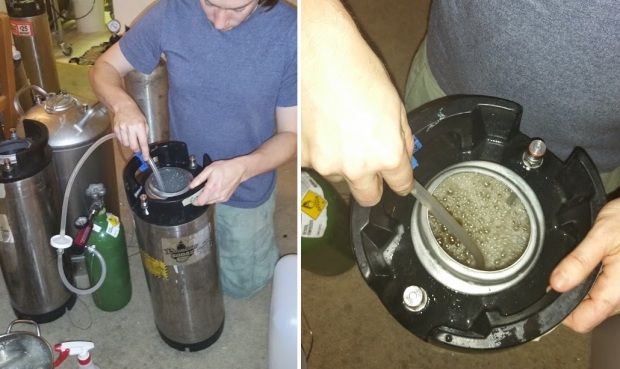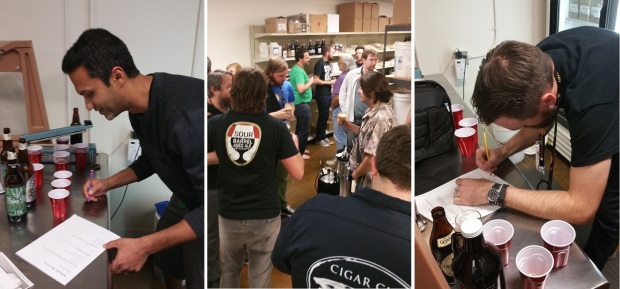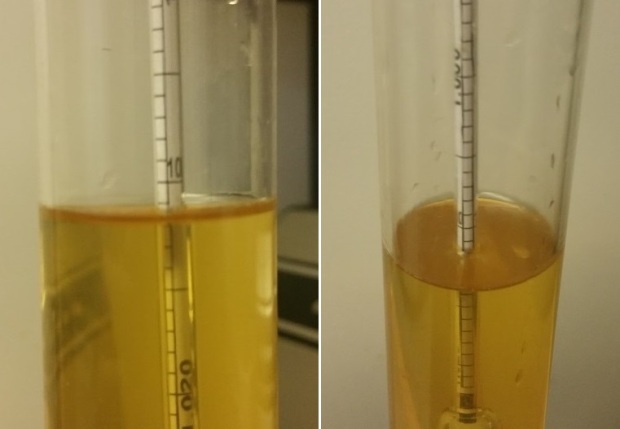Years ago, during one of my frequent moments of homebrew soul searching (i.e., coming up with excuses to buy shiny new gear), I got it in my head that the key missing ingredient in my process was oxygen (O2). Like many homebrewers, I’d been employiong the shake method since I first started homebrewing, a rudimentary process that involves shaking the living hell out of a fermentor full of chilled wort. A couple minutes of this and voila, it’s oxygenated.
As I progressed in the hobby, the shake method began to seem like a less viable option. First of all, it’s difficult to know just how much shaking is required to add the proper amount of oxygen to the wort. Then I had the realization this method relies on dissolving air from the immediate environment into a liquid I would later be ingesting… dirty, contaminated air.
This is when I decided go with pure O2 and was convinced I’d found the missing piece of the puzzle. I bought myself a lovely set-up and have used it for every batch since. I’ve been so committed to the idea pure O2 is an essential component to good beer that I’ve delayed brewing due to an empty tank. And you know what? It was worth it, my beers got better! The forum posts were right, pure O2 really did make a difference. I basked in the glory of my shiny new rig, confident I’d made a worthy investment.
Or at least that’s what I thought at the time.
Years later, I developed a nagging feeling inside, a deep inner questioning about my process– is pure O2 really necessary? Is it really the huge factor I thought it was years ago? Only one way to find out!
| PURPOSE |
To evaluate the differences between shake aeration and the use of pure oxygen on a split-batch of the same beer.
| METHOD |
For this xBmt, I decided to go with a light but aromatic Cream Ale recipe originally intended to be a light, easy drinker with strong hop aromatics. I’d brewed it a few months earlier using all Cascade hops and the result was a surprisingly delicious success. Keg depleted and interested in playing with other hop varieties, I swapped the Cascade for the ever popular Amarillo in this batch. The name pays homage to my organoleptic experience with this beer.
Cat Piss and Cream Recipe
| Batch Size | Boil Time | IBU | SRM | OG | FG | ABV |
| 9 gal | 60 min | 7.8 | 9.7 | 1.053 SG | 1.012 SG | 5.37% |
Fermentables
| Name | Amount | % |
| Maris Otter | 14 lbs | 76% |
| Instant Rice | 1.5 lbs | 8% |
| Flaked Maize | 1 lbs | 5% |
| Munich (10L) | 1 lbs | 5% |
| Acid Malt | 12 oz | 4% |
| Carapils | 6 oz | 2% |
Hops
| Name | Amt | Time | Use | Form | Alpha % |
| Amarillo | 2 oz | 4 min | Boil | Pellet | 8.5% |
| Amarillo | 6 oz | 40 min steep | Whirlpool at 185˚F | Pellet | 8.5% |
Yeast
| Name | Lab | Attenuation | Ferm Temp |
| Safale US-05 | Fermentis | 77% | 66°F |
This brew day would have been a real struggle due to some leg pain if it weren’t for the assistance of my brew buddy, Maggie, whom I reluctantly agreed to refer to as the Brew Bitch (her request, she’s a wonderful person). Thanks to her doing the heavy lifting, the day went swimmingly. We mashed at 151˚F and recirculated for an hour before transferring the wort to the kettle. After a quick batch sparge, I brought the full volume of wort up to a boil and let it rip for another hour. On a whim, I added the first aroma hop charge at 4 minutes until flameout. Once the boil ended, I was excited to finally test out my new homemade counterflow chiller (CFC).

I cut the chiller off at 185˚F and added the remaining hops to the kettle for an extended 40 minute steep. The entire batch was then cooled and split equally between 2 corny kegs that would be used as fermentation vessels.

Maggie graciously volunteered to prepare the shake method batch, putting her CrossFit training to good use as she shook the crap out of the keg for a solid 90 seconds.

I, on the other hand, chose the much less physically demanding route and prepared the pure O2 batch by dropping in a tube with a .5 micron stone, opening a regulator valve, then waiting 2 minutes.

With both batches aerated in their respective ways, I pitched the rehydrated yeast and placed the fermentors in my chamber controlled to 66˚F.
One downside to fermenting in kegs is the fact you can’t see the typical signs things are going well, so my solution is to monitor fermentation activity by periodically checking the bubbles coming from the blowoff tubes. I was surprised to find both batches showed signs of fermentation at an identical time, progressed similarly, then finished at nearly the same FG simultaneously.
I have to admit, I was hesitant to continue this xBmt because of the strong cat piss aroma I got from these samples. But in the name of science, I forged ahead! Both beers were force carbonated and shared a similar appearance by the time they were presented to tasters.

| RESULTS |
Data for this xBmt was collected at a Pacific Gravity Homebrew Club monthly meeting where 21 members were kind enough to volunteer their tasting devices to the cause. All participants were provided 3 samples, 2 from the shake aeration batch and 1 from the pure O2 batch, then asked to select the odd-beer-out. Establishing a statistically significant result at this sample size would require 12 tasters (p<0.05) to accurately select the different beer in the triangle test; only 9 tasters (p=0.36) were capable of doing so, suggesting the beer aerated via shaking was largely indistinguishable from the one dosed with pure O2. Some may find it interesting to note that one of the similar samples was endorsed with an equal frequency as the different sample, while only 3 tasters selected the other similar sample.

Immediately following the triangle test, participants were asked to select how confident they were in their selection, the results of which left me somewhat confounded.
| Level of Confidence | Correct | Incorrect |
| Not very confident | 1 | 0 |
| Somewhat confident | 6 | 3 |
| Very confident | 1 | 6 |
| Absolutely confident | 1 | 3 |
Taken at face value, this data appears to indicate an inverse relationship between level of confidence and likelihood of being wrong– killed by confidence! Go figure. I originally lobbied the team to add this question because I thought perhaps some “super” tasters might be able to discern subtle differences in triangle tests that the average person could not. I hoped I might discover these superior palates using this question as they would be more certain about their selection, but unfortunately multiple xBmts have failed to support this notion, hence our decision to drop it from the survey.
My Impressions: My experience testing these beers mimics the data above in that I couldn’t reliably tell a difference. I tried triangle testing myself multiple times and repeatedly failed. The fact of the matter is I was keenly aware of my own bias and fully expected to fail. I originally hypothesized the pure O2 batch would be the first to take off fermenting and do so with greater vigor. When this clearly didn’t occur, I couldn’t help but speculate that both batches likely had “enough” oxygen and therefore wouldn’t be noticeably different. A small part of me still thought perhaps some contaminated air particles might create differences in the shake batch, but for the most part, I was expecting them to be about the same, and I was right.
| DISCUSSION |
This xBmt did not yield statistically significant results, something I believe may be due to the lower O2 requirements of the moderate OG base beer. Would the outcome have been different if the wort was of a higher OG? Given the results of Ray’s recent shaken vs. no oxygen xBmt, I’m keen on testing the differences between the same high OG wort hit with pure O2 vs. no aeration at all. Consider it added to the top of the xBmt list!
As for me, I will continue to use pure O2, not only because I like knowing the yeast are well taken care of, but it also alleviates my hypochondriacal fears of some evil contaminant making it into my beer and spoiling a batch. Plus, I already have the fancy gear and it’s easy enough to use, no reason it should collect dust!
On a final note, please be cautious when interpreting these results as they are merely a single data point from a single xBmt. In no way am I claiming the use of O2 isn’t important, but rather that a group of participants were unable to reliably distinguish between samples of a particular beer in a particular setting. Cheers!

No comments:
Post a Comment